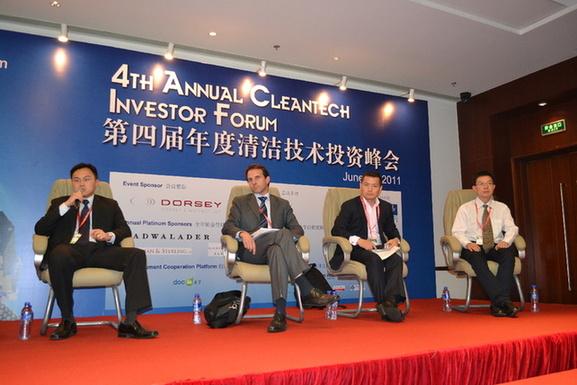A buzz of excitement permeated the room at the 4th Annual Cleantech Investor Forum on June 21 in Beijing. Some of the world's top investment managers, market analysts, and consultants in green technology shared their predictions about long and short-term investment trends and gave advice to firms about how to best take advantage of China's big green push.
As China nears the halfway mark of its first year of the 12th Five Year Plan for National Economic and Social Development (12th FYP) , the climate remains ripe for investment in a new generation of clean technologies which will potentially shape the country's future. The shift of wind power production in China from on-shore to off-shore presents new investment opportunities for foreign firms, panelists said. Also, investment in key technology components, such as generator parts, as opposed to larger scale enterprises like wind farms or solar panels, will drive near-term investment. In addition, many of the forum speakers agreed that investment in "disruptive" or industry-changing technologies is not always commercially feasible in the short run.
Peter Corne, a Partner of Dorsey & Whitney LLP, which represents investors in clean tech and renewable energy, said off-shore wind provides "tremendous" opportunities for foreign technology providers, especially in the areas of turbine manufacturing, safety equipment, and stabilization technology. In addition, high wind speeds not far off China's southern and eastern coastlines create a favorable environment for off-shore wind power.

Despite the media attention surrounding alternative energy generation, many money managers who follow the renewable energy market are now moving away from the so-called 'big sectors' like wind and solar power. Investors are putting more money into new emerging sectors such as green building technologies, LED lighting, and smart grid technologies, said Jun Ying, Head of Research for China at Bloomberg New Energy Finance, which provides market analysis for the clean energy market.
Marc Schueler, Managing Director of the China branch of Dutch venture capital firm DSM, argued that investments in "traditional industries" in clean-tech such as wind and solar power generation were often too risky in the long term due to technology shifts. He said often the best investments not always involve the latest technology, but the best application to circumstances on the ground in China.

Corne said a specific technology's price point as well as its application in solving local problems in China were key factors in winning over investors. "China is a very competitive place to do business," he said. "You can't afford to continue to sell your technology on the basis of quality - it has to be competitive on an economic level as well."
"Most of the projects I've been associated with that have been successful were not state-of-the art," Corne said. Projects where cutting-edge technology is brought to China without being modified to suit Chinese conditions often fail, he said.
Investors both from China and abroad are heeding the Chinese government's call and betting heavily on the green technology sector. One-third of the 12th FYP's social and economic targets relate to natural resources and environmental issues, according to a June 2011 report on encouraged industries for foreign investment by China Briefing magazine. Even more compelling are the 12th FYP's commitments to reducing carbon dioxide emissions per unit of GDP by 40 to 45 percent of the 2005 level and increase the percentage of non-fossil fuels in primary energy consumption to 15 percent by 2020.
The Chinese government provides significant opportunities for foreign clean tech firms to conduct research and development and pilot projects in China, Corne said. In addition, he said, foreign firms' R&D projects can receive grants from local governments to finance up to one-third of the total project costs. However, he said foreign firms need to pick their project locations carefully.
He cited the city of Urumqi, in northwest China's Xinjiang province, among other locations, as being very receptive to clean energy projects this year.
"[Urumqi] is a clean energy hub," Corne said. "They have over 2 billion (yuan) [in grant funding] to spend this year."
The near-capacity crowd of 100 industry professionals at the forum, sponsored by the CEBEX Group, included private investors, representatives of small and medium technology suppliers as well as venture capitalists.
Cam Smith, who works in business development for OnGreen, an online marketplace for the clean tech industry, attended the forum. He said his company was seeking to connect Chinese investors to green technology companies and projects in the U.S.
Smith said he thought China has come along way in terms of innovation in renewable energy technologies, but still needed the help of foreign partners to further innovate.
The clean tech investment community in China is "still coming together," he said.
The forum coincided with the opening day China's Clean Energy Expo, which drew over 300 exhibitors from 30 countries, and drew an estimated 17,000 visitors from corporations, industry associations, government agencies and the media. During the three-day expo, exhibitors showcased a wide range of technologies marketed both domestically and internationally, including solar panels, wind turbines, components for renewable energy generators, and even new "smart grid" technology that can make power grids more receptive to alternative energy sources.





